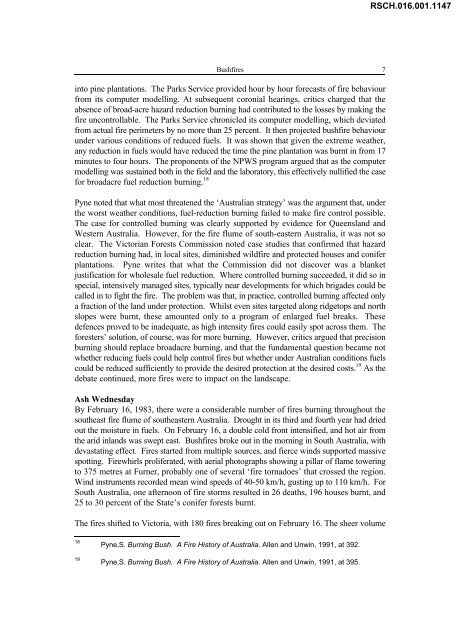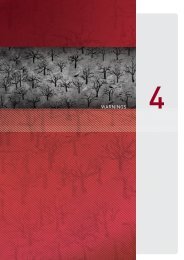RSCH.016.001.1136 - 2009 Victorian Bushfires Royal Commission
RSCH.016.001.1136 - 2009 Victorian Bushfires Royal Commission
RSCH.016.001.1136 - 2009 Victorian Bushfires Royal Commission
You also want an ePaper? Increase the reach of your titles
YUMPU automatically turns print PDFs into web optimized ePapers that Google loves.
RSCH.016.001.1147<br />
<strong>Bushfires</strong> 7<br />
into pine plantations. The Parks Service provided hour by hour forecasts of fire behaviour<br />
from its computer modelling. At subsequent coronial hearings, critics charged that the<br />
absence of broad-acre hazard reduction burning had contributed to the losses by making the<br />
fire uncontrollable. The Parks Service chronicled its computer modelling, which deviated<br />
from actual fire perimeters by no more than 25 percent. It then projected bushfire behaviour<br />
under various conditions of reduced fuels. It was shown that given the extreme weather,<br />
any reduction in fuels would have reduced the time the pine plantation was burnt in from 17<br />
minutes to four hours. The proponents of the NPWS program argued that as the computer<br />
modelling was sustained both in the field and the laboratory, this effectively nullified the case<br />
for broadacre fuel reduction burning. 18<br />
Pyne noted that what most threatened the ‘Australian strategy’ was the argument that, under<br />
the worst weather conditions, fuel-reduction burning failed to make fire control possible.<br />
The case for controlled burning was clearly supported by evidence for Queensland and<br />
Western Australia. However, for the fire flume of south-eastern Australia, it was not so<br />
clear. The <strong>Victorian</strong> Forests <strong>Commission</strong> noted case studies that confirmed that hazard<br />
reduction burning had, in local sites, diminished wildfire and protected houses and conifer<br />
plantations. Pyne writes that what the <strong>Commission</strong> did not discover was a blanket<br />
justification for wholesale fuel reduction. Where controlled burning succeeded, it did so in<br />
special, intensively managed sites, typically near developments for which brigades could be<br />
called in to fight the fire. The problem was that, in practice, controlled burning affected only<br />
a fraction of the land under protection. Whilst even sites targeted along ridgetops and north<br />
slopes were burnt, these amounted only to a program of enlarged fuel breaks. These<br />
defences proved to be inadequate, as high intensity fires could easily spot across them. The<br />
foresters’ solution, of course, was for more burning. However, critics argued that precision<br />
burning should replace broadacre burning, and that the fundamental question became not<br />
whether reducing fuels could help control fires but whether under Australian conditions fuels<br />
could be reduced sufficiently to provide the desired protection at the desired costs. 19 As the<br />
debate continued, more fires were to impact on the landscape.<br />
Ash Wednesday<br />
By February 16, 1983, there were a considerable number of fires burning throughout the<br />
southeast fire flume of southeastern Australia. Drought in its third and fourth year had dried<br />
out the moisture in fuels. On February 16, a double cold front intensified, and hot air from<br />
the arid inlands was swept east. <strong>Bushfires</strong> broke out in the morning in South Australia, with<br />
devastating effect. Fires started from multiple sources, and fierce winds supported massive<br />
spotting. Firewhirls proliferated, with aerial photographs showing a pillar of flame towering<br />
to 375 metres at Furner, probably one of several ‘fire tornadoes’ that crossed the region.<br />
Wind instruments recorded mean wind speeds of 40-50 km/h, gusting up to 110 km/h. For<br />
South Australia, one afternoon of fire storms resulted in 26 deaths, 196 houses burnt, and<br />
25 to 30 percent of the State’s conifer forests burnt.<br />
The fires shifted to Victoria, with 180 fires breaking out on February 16. The sheer volume<br />
18<br />
19<br />
Pyne,S. Burning Bush. A Fire History of Australia. Allen and Unwin, 1991, at 392.<br />
Pyne,S. Burning Bush. A Fire History of Australia. Allen and Unwin, 1991, at 395.
















